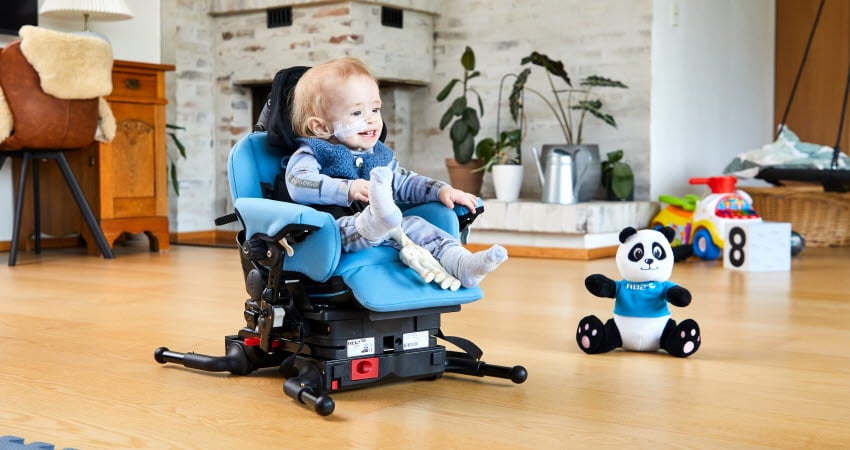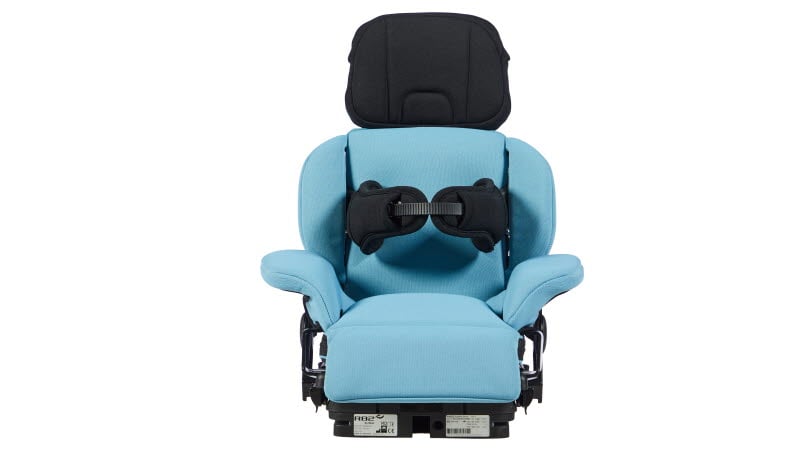
Meet Aksel
On a cold April day we met Aksel and his mother Sabrine.
Aksel lives with his mother and father in a small town close to Vejle in Denmark. They live in a cosy house with a lot of space for Aksel and their two dachshunds.
Aksel and his family enjoy going for walks with their dogs in their neighbourhood and a favourite excursion is to the local and very idyllic Børkop Watermill.
Aksel is one year old and is a very active, happy and curious boy. He is constantly exploring his surroundings and keeping his parents busy. Aksel has Silver-Russell Syndrome. At birth he was 47 cm long and weighed only 2800 g. Today, he is 64 cm long and weighs 5 kg. Aksel and his family attend regular visits to the local hospital where his development and growth is monitored by specialists in rare diseases.
Aksel can sit without support, and he uses his arms and hands for postural support to keep his balance. He is exploring his surroundings by laying on his stomach and using his arms and hands to get from one place to another. In his weekly sessions with his paediatric physiotherapist, he has been practicing getting up on all four and is now beginning to do so, on his own, at home – so it can’t be long before he is crawling full speed ahead.
An important daily focus for Aksel is to get enough to eat and drink. Aksel has just grown two front teeth. More are on their way, which makes eating more difficult for him. Aksel has a nasogastric tube to ensure adequate nutrition and energy for growth and his general development. When Aksel is eating it is important for him that he is happy and comfortable in the seat he is sitting in. If he is not happy with the seat, his mouth stays closed.
Aksel sits in an x:panda shape infant seat several times a day. The infant seat provides a comfortable and secure seat that provides a stable base of support for him. Aksel has full head control but uses a head support in case of the need to recline the back or tilting the seat backwards for a bit of relaxation. The surrounding support, the y-hip belt and the hip supports creates the optimal conditions for a stable pelvis. The build-in wedge creates a contour in the cushion, and by creating a seat pit it helps stabilize the pelvis in the seat.
By being fully supported by the infant seat Aksels hands and arms are now free for play and exploration. The new tray provides the opportunity to play with suction toys or sensory play with sand or water.
When we combined the infant seat with the Floor frame Aksel was able to sit in his infant seat but still be close to the floor where he could play and interact with his mother. The Floor frame offered tilt and the infant seat back recline, which enabled Aksel to get a little break, in between all the active fun.
When it was time for a little snack, we easily transformed the Floor frame with the infant seat from a floor sitter to a supportive seat at dinner table height by switching out the short legs with the long legs. The frame is very lightweight, so it was easy to move from the living room to the dinner table.
Facts about Silver-Russell Syndrome:
Silver-Russell Syndrome (SRS), or Russell-Silver Syndrome, as it is called in the United States, is a rare genetic disorder, often diagnosed in infancy or early childhood. SRS is characterized by a birth weight and birth length well below the 3rd percentile, meaning children with SRS are born very small and continue to be significantly smaller than their typical developing peers throughout their life.
The symptoms of SRS exhibit significant variation among the children. While some experience mild symptoms, others may encounter more severe complications.
Besides restricted growth, some of the most common symptoms include poor appetite, feeding difficulties, hypoglycaemia, asymmetry between left and right side of the body, scoliosis, hand and foot abnormalities, abnormalities affecting different internal organs, increased head circumference, delayed motor development due to low muscle tone and delayed speech development.
Management of SRS involves a multidisciplinary approach, with a team of healthcare professionals collaborating to address various aspects of the condition. This may include monitoring growth and development, nutritional support, speech therapy, and addressing any associated medical complications.
Despite the challenges posed by SRS, early intervention and ongoing support can significantly improve outcomes for individuals affected by the syndrome. Regular monitoring and medical management are essential to address potential complications and optimize the overall well-being of individuals with SRS throughout their lifespan.
Research into the underlying genetic mechanisms and advancements in treatment modalities continue to enhance our understanding and management of this complex disorder.
References
https://rarediseases.org/rare-diseases/russell-silver-syndrome/
https://www.magicfoundation.org/Growth-Disorders/Russell-Silver-Syndrome/
https://rarediseases.info.nih.gov/diseases/4870/silver-russell-syndrome
Related products

R82 x:panda shape
The x:panda shape is highly configurable and provides tailored support to fit the individual needs.
Please note
A case story is used to show an individual product solution and the experiences related to its use.
The configuration and use of the product, including its accessories is determined based on the preferences of the user, their healthcare professionals, the environment, constraints and local market-specific preferences. The case story is only a supplement to the product's manual/assembly instructions and does not in any way replace these instructions. Products, sizes, configurations, accessories shown might not be available on all markets. Please contact your local sales organization for updated information on availability in your country.